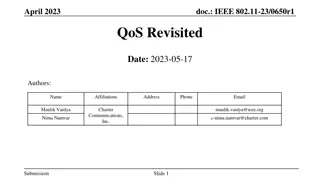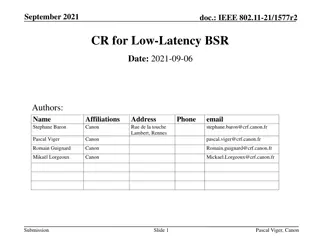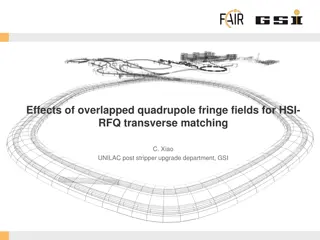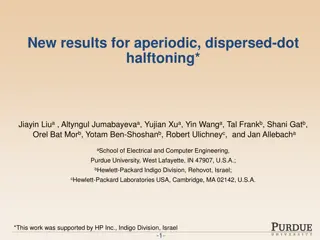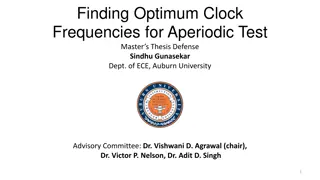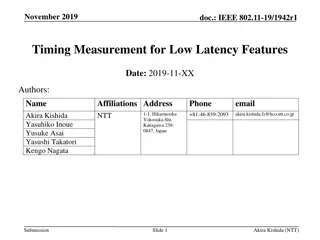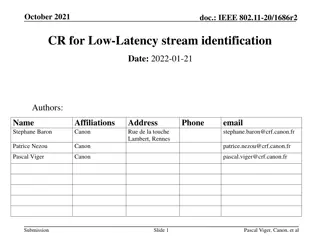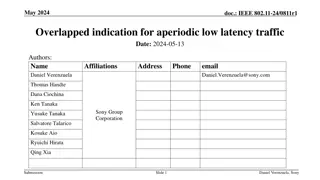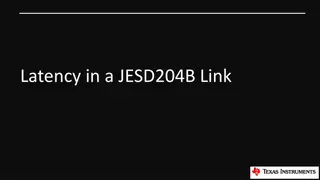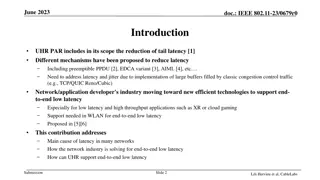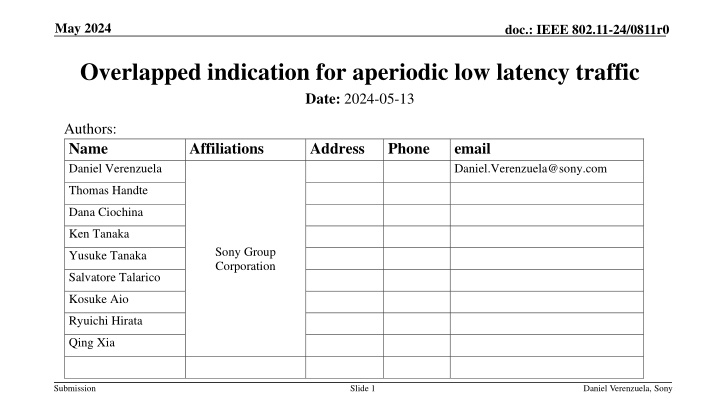
IEEE 802.11-24/0811r0 Overlapped Indication for Aperiodic Low Latency Traffic
Explore the significance of overlapped indication in supporting aperiodic low latency traffic in the realm of IEEE 802.11-24/0811r0. This document delves into the challenges of handling such traffic, proposes solutions for efficient channel access, and evaluates the benefits of overlapped indication for transmission opportunity preemption. Gain insights into the innovative approaches for enhancing latency, throughput, and overall efficiency in UL preemption scenarios.
Download Presentation

Please find below an Image/Link to download the presentation.
The content on the website is provided AS IS for your information and personal use only. It may not be sold, licensed, or shared on other websites without obtaining consent from the author. If you encounter any issues during the download, it is possible that the publisher has removed the file from their server.
You are allowed to download the files provided on this website for personal or commercial use, subject to the condition that they are used lawfully. All files are the property of their respective owners.
The content on the website is provided AS IS for your information and personal use only. It may not be sold, licensed, or shared on other websites without obtaining consent from the author.
E N D
Presentation Transcript
May 2024 doc.: IEEE 802.11-24/0811r0 Overlapped indication for aperiodic low latency traffic Date: 2024-05-13 Authors: Name Daniel Verenzuela Affiliations Address Phone email Daniel.Verenzuela@sony.com Thomas Handte Dana Ciochina Ken Tanaka Sony Group Corporation Yusuke Tanaka Salvatore Talarico Kosuke Aio Ryuichi Hirata Qing Xia Submission Slide 1 Daniel Verenzuela, Sony
May 2024 doc.: IEEE 802.11-24/0811r0 Introduction Support of aperiodic low latency (LL) traffic is important for 11bn TXOP preemption opportunity is made via Short PPDUs with xIFS gaps [1,2,6,9,10] Preemption request and response exchange [3,7,8,11] Unified preemption request frame and LL traffic protection [4] Preemption priority indication [5] Overlapped indication in TB-PPDU to enable UL preemption [12] Independent of LL channel access mechanism LL traffic awareness is necessary This contribution provides evaluation of overlapped indication for TXOP preemption Introduce use case in EDCA UL TXOP Simulation results for: Reliability of ongoing PPDU with several MCS and probability of overlapped indication detection Latency improvements from using overlapped indication in UL preemption Total throughput efficiency impact Submission Slide 2 Daniel Verenzuela, Sony
May 2024 doc.: IEEE 802.11-24/0811r0 Recap: problem of aperiodic LL traffic awareness LL traffic originates at LL_STA that is neither TXOP holder nor responder LL_STA needs to wait until TXOP ends to start contention for channel access LL traffic arrival is unpredictable LL_STA channel access can suffer long delays in dense scenarios TXOP AP (TXOP responder) CTS BA BA Other STAs could win contention STA 1 (TXOP Holder) RTS PPDU PPDU LL_STA LL data Channel access delay LL arrival Submission Slide 3 Daniel Verenzuela, Sony
May 2024 doc.: IEEE 802.11-24/0811r0 Overlapped LL Indication (OLLInd) for LL awareness OLLInd assumptions Short OFDM signal synchronized to OFDM symbols of ongoing PPDU OLLInd TX power previously agreed with AP or derived from preamble information in ongoing PPDU Indicates LL traffic arrival and can identify LL_STA Can also give a basic buffer status indication (above or below certain threshold) AP can detect OLLInd with simple correlation detector TXOP Fast LL awareness AP (TXOP responder) CTS Preemption mechanism possible STA 1 (TXOP Holder) RTS Ongoing PPDU LL_STA OLLInd LL arrival Submission Slide 4 Daniel Verenzuela, Sony
May 2024 doc.: IEEE 802.11-24/0811r0 UL preemption using overlapped LL Indication (OLLInd) Basic TXOP preemption assumptions Reduce PPDU size to allow preemption opportunities (PPDU length ~1ms) TXOP holder can send preemption allowed indication in UL PPDU Once AP is aware of LL traffic a preemption mechanism can be applied AP can send preemption indication (PI) frame to notify STAs of preemption event and Trigger LL data, collect BSR, use NFRP or UORA, allow EDCA, etc. TXOP AP (TXOP responder) CTS BA PI+BA TF BA BA Ongoing PPDU STA 1 (TXOP Holder) RTS PPDU PPDU PPDU LL_STA LL data OLLInd LL arrival Reduced access delay Submission Slide 5 Daniel Verenzuela, Sony
May 2024 doc.: IEEE 802.11-24/0811r0 Comparison with basic frame-base preemption method Increased efficiency Inserting IFS gaps longer than SIFs is not necessary BSR or NFRP is not necessary (OLLInd can identify the LL_STA and give basic buffer status) Additional processing and signaling at the AP Correlation filter to detect OLLInd (low complexity compared to OFDM demodulation) AP indicates LL_STA target RSSI to achieve desired SIR Submission Slide 6 Daniel Verenzuela, Sony
May 2024 doc.: IEEE 802.11-24/0811r0 High reliability for ongoing PPDU and OLLInd Simulation set up Channel type D Ongoing PPDU: 20MHz SU-PPDU OLLInd: 20 MHz 11ax waveform. Wide range of MCS supported for ongoing PPDU transmission Low MCS => short OLL Ind. with moderate power High MCS => Long OLL ind. with low power SNR gap 0 to 3dB on PER OLL Ind. Prob. Detection > 99% OLL Ind. Prob. False alarm < 2.5% Target PER < 10% SIR =Rx Pw ongoing PPDU Rx Pw OLLInd Nsym = # OFDM symbols in OLLInd Submission Slide 7 Daniel Verenzuela, Sony
May 2024 doc.: IEEE 802.11-24/0811r0 Latency gains increase with number of contending STAs Gain LL STA Single BSS UL traffic only, MCS 4, 20MHz Max PPDU duration 1ms. Max TXOP duration 5ms One LL STA: traffic CBR 2Mbps, 1.5KB MPDU AC: VO Non-LL STAs: traffic CBR 4Mbps, 1.5KB MPDU AC: BE LL STA latency gains > 60% latency reduction with > 8 contending STAs Impact to non-LL STAs 3% Latency reduction with 8 contending STAs Overall throughput unaffected Loss Non-LL STA Gain All STAs Submission Slide 8 Daniel Verenzuela, Sony
May 2024 doc.: IEEE 802.11-24/0811r0 Gain High latency gains for LL-STAs Low latency gains for AC_VI non-LL STAs LL STA Single BSS UL traffic only, MCS 4, 20MHz Max PPDU duration 1ms. Max TXOP duration 5ms One LL STA: traffic CBR 2Mbps, 1.5KB MPDU AC: VO Non-LL STAs: traffic CBR 4Mbps, 1.5KB MPDU AC: VI LL STA latency gains ~34% with low number of contending STAs >80% with > 8 contending STAs Impact to non-LL STAs Small latency reduction for non-LL STAs Due to LL STA not contending as often Marginal throughput loss in dense scenarios (12 STAs) Non-LL STA Gain Loss All STAs Submission Slide 9 Daniel Verenzuela, Sony
May 2024 doc.: IEEE 802.11-24/0811r0 Gain Large latency gains for LL-STA contending with AC_VO STAs LL STA Single BSS UL traffic only, MCS 4, 20MHz Max PPDU duration 1ms. Max TXOP duration 5ms One LL STA: traffic CBR 2Mbps, 1.5KB MPDU AC: VO Non-LL STAs: traffic CBR 4Mbps, 1.5KB MPDU AC: VO 50% to 98% LL STA latency gains Low impact to non-LL STAs Small latency loss with 4 STAs (short contention time) Small latency gain with 8 STAs (long contention time) Marginal throughput loss in dense scenarios (12 STAs) Non-LL STA Gain Loss Loss All STAs Submission Slide 10 Daniel Verenzuela, Sony
May 2024 doc.: IEEE 802.11-24/0811r0 Conclusion An overlapped LL indication solves the problem of LL traffic awareness at STAs not part of ongoing TXOP traffic exchange Overlapped LL indication design achieves Low impact on reliability of ongoing PPDU for wide range of MCS High detection probability Preemption with overlapped LL indication gives large latency reduction 50% to 98% latency reduction for LL-STAs Small impact to non-LL STAs Some positive cases of up to 7% latency reduction No more than 3% latency increase in negative cases Marginal throughput loss in dense scenarios (12 STAs) Submission Slide 11 Daniel Verenzuela, Sony
May 2024 doc.: IEEE 802.11-24/0811r0 SP 1 Do you support the use of an overlapped indication for non-AP STAs to inform AP of traffic arrival Submission Slide 12 Daniel Verenzuela, Sony
May 2024 doc.: IEEE 802.11-24/0811r0 References [1] 11-23/1229r1 Preemption for low latency application (Follow up) [2] 11-23/1886r3 Preemption techniques to meet low-latency (LL) targets [3] 11-23/1909r1 Transmission Method of Low Latency Traffic [4] 11-23/1950r0 Considerations on Preemption Request [5] 11-23/1939r1 Priority Based Preemption Method [6] 11-24/0103r1 TXOP level preemption for Low latency application in 802.11bn [7] 11-24/0091r0 Enhanced Scheduling Method for LL Traffic Follow up [8] 11-24/0168r0 TXOP Preemption in 11bn [9] 11-24/0416r1 Target STA Prioritization in EDCA-based Preemption Mechanisms during a DL TXOP [10] 11-24/0470r0 Re-thinking latency: the missing pieces [11] 11-24/0431r2 Signal for preemption request [12] 11-23/1194r0 Overlapped Indication to Support Preemption Submission Slide 13 Daniel Verenzuela, Sony

